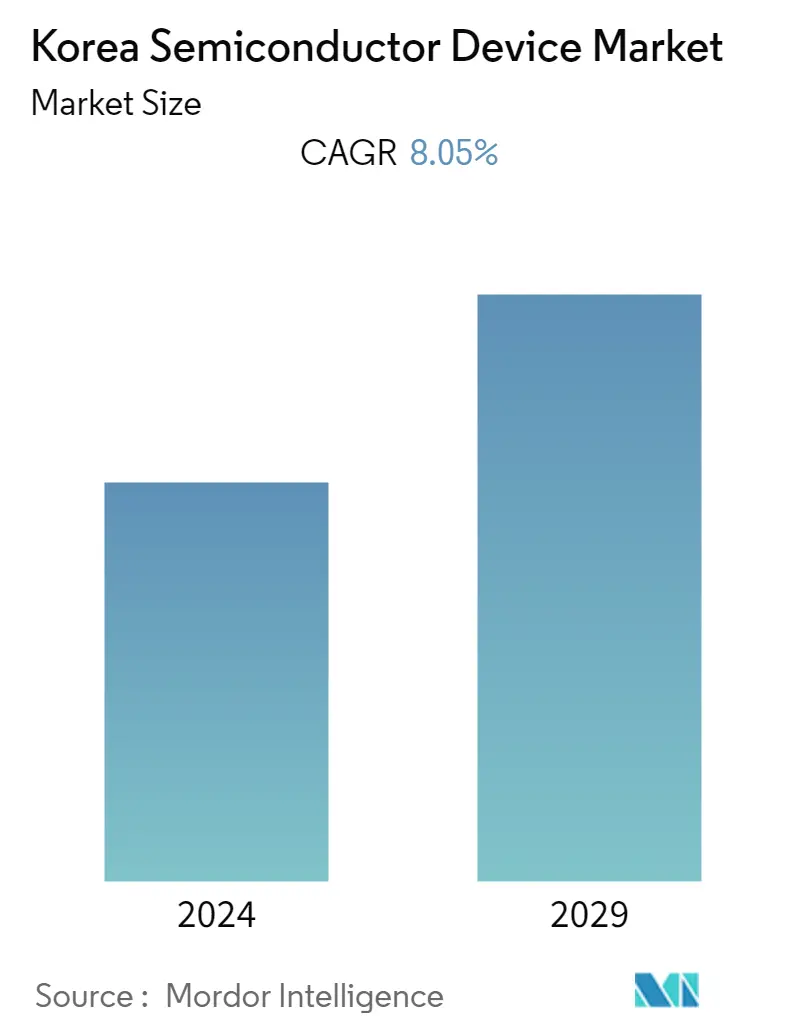Market Size of Korea Semiconductor Device Industry

| Study Period | 2019 - 2029 |
| Base Year For Estimation | 2023 |
| Forecast Data Period | 2024 - 2029 |
| Historical Data Period | 2019 - 2022 |
| CAGR | 8.05 % |
| Market Concentration | Low |
Major Players*Disclaimer: Major Players sorted in no particular order |
Need a report that reflects how COVID-19 has impacted this market and its growth?
Korea Semiconductor Device Market Analysis
The Korean semiconductor device market is valued at USD 105.23 billion in the current year and is expected to register a CAGR of 8.05% during the forecast period to become USD 167.45 billion by the next five years.
- The increasing demand for semiconductor devices from the electronics and automotive industries is expected to contribute significantly to revenue generation in the coming years; however, a shortage of skilled labor-intensive tasks may impede industry expansion in the coming years.
- The South Korean Government is taking several steps to strengthen its semiconductor landscape. For instance, in 2022, the Ministry of Trade, Industry, and Energy announced that chip exports are anticipated to double to USD 200 billion by 2030.
- Further, the Korean Government seeks to build a "K-Semiconductor belt" that stretches several kilometers south of Seoul and brings together chip designers, manufacturers, and suppliers. These plants are aimed to sharpen South Korea's competitive edge in the global semiconductor industry as well as localize primary semiconductor materials and equipment supplies with key semiconductor companies and their suppliers working in clusters in the midst of a global chip shortage.
- In Sep 2022, the South Korean Government announced several strategies to boost its automotive industry, including South Korea to invest KRW 95 trillion in the automobile industry over the next five years. The Government plans to produce 3.3 million electric vehicles by 2030.
- In March 2023, South Korea unveiled plans to utilize USD 234 billion in private investment to create the world's largest semiconductor cluster in the Seoul metropolitan area. The cluster would be located in the Gyeonggi province and completed by 2042. The cluster would be located in the Gyeonggi province and completed by 2042. South Korea's Trade and Industry Ministry also revealed its plans to build five high-tech semiconductor factories and attract up to 150 sub-manufacturers and fabless companies.
- Moreover, in August 2022, Hyundai Motor Group of South Korea announced that it had opted to develop its own automotive semiconductors. Hyundai Mobis, the automaker's car components business, is now ramping up its efforts to manufacture its own semiconductors. The move is considered part of a strategy to deal with the concerns of semiconductor supply shortages, which have made internal semiconductor production more critical than ever before, especially with the shift to electric vehicles. Such developments would offer lucrative opportunities for the market players.
- On the flip side, the semiconductor industry is considered to be one of the most complex industries, not only due to over 500 processing steps involved in the manufacturing and several products but also the harsh environment it faces, for instance, the volatile electronic market and the unpredictable demand.
- Depending on the complexity of the manufacturing process, there can be around 1,400 process steps in the overall manufacturing of semiconductor wafers alone. Transistors are formed on the lowest layer, but the process is repeated as numerous layers of circuits are formed to create the final product. The complexity of manufacturing semiconductor devices is likely to restrain the growth of the studied market.
- Further, according to the Korea Automotive Technology Institute or Katech, the global shortage of automotive semiconductors that started around the end of the year 2020 continued to affect the global car industry for the first half of the year 2022. Even after 2023, some companies may still feel its effects.
- Up to September 2021, major global automakers such as Volkswagen, Stellantis, GM Motors, and Honda witnessed their respective accumulated production volume fall by around 30% from the same period in 2019, according to Katech. The momentary decline in the automotive industry in Korea might also act as a restraining factor in the short term for the studied market.
